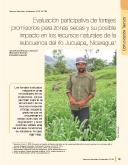| dc.contributor.author | Payán, Arlen | |
| dc.contributor.author | Jiménez Otárola, Francisco | |
| dc.contributor.author | Ibrahim, Muhammad Akbar | |
| dc.contributor.author | Casanoves, Fernando | |
| dc.date.accessioned | 2015-03-19T21:33:10Z | |
| dc.date.available | 2015-03-19T21:33:10Z | |
| dc.date.issued | 2007-04 | |
| dc.identifier | 471976 | es_ES |
| dc.identifier.issn | e-ISSN: 1659-1216 | es_ES |
| dc.identifier.uri | https://repositorio.catie.ac.cr/handle/11554/6289 | |
| dc.description | 3 ilustraciones, 12 referencias, 6 páginas. | es_ES |
| dc.description.abstract | Se desarrolló un proceso de investigación-acción con productores ganaderos y funcionarios, con el fin de evaluar el comportamiento y el potencial de dos pasturas y una leguminosa para mejorar la calidad y cantidad de alimento para el ganado, reducir la degradación de los recursos naturales y favorecer las condiciones socioeconómicas de los productores ganaderos en la subcuenca del río Jucuapa, Nicaragua. Las especies evaluadas fueron las pasturas Brachiaria brizantha x Brachiaria ruziziencis y Brachiaria brizantha y la leguminosa Cratylia argentea bajo dos sistemas de siembra: transplante y siembra directa. La metodología participativa incluyó: establecimiento de parcelas demostrativas, días de campo, entrevistas y un taller participativo.Los productores ganaderos mostraron mucho interés en continuar con el establecimiento de B. brizantha x B. ruziziencis y B. brizantha y un menor interés en C. argentea. | es_ES |
| dc.description.abstract | A participative actionresearch process was developed with participation of farmers and institutional officers in Jucuapa River subwatershed, Nicaragua, with the purpose of evaluating the behavior and potential of two pastures and a leguminous for improving the quality and quantity of cattle feeding, reducing natural resources degradation, and improving livelihood conditions. The species evaluated were the pastures Brachiaria brizantha x Brachiaria ruziziencis and Brachiaria brizantha, and the leguminous Cratylia argentea two planting system (transplant and direct planting) were evaluated. The participative methodology included the establishment of demonstrative plots, field trips, interviews, and a participative workshop. Farmers were highly interested on B. brizantha x B. ruziziencis and B. brizantha, but less interested on C. argentea. | |
| dc.language.iso | es | es_ES |
| dc.publisher | CATIE, Turrialba (Costa Rica) | es_ES |
| dc.relation.ispartof | Recursos Naturales y Ambiente. Número 51-52 (Agosto-Diciembre 2007), páginas 161-166 | |
| dc.rights | info:eu-repo/semantics/openAccess | |
| dc.subject | BRACHIARIA BRIZANTHA | es_ES |
| dc.subject | FORRAJES | es_ES |
| dc.subject | SISTEMAS DE CULTIVO | es_ES |
| dc.subject | TRASPLANTE | es_ES |
| dc.subject | SIEMBRA DIRECTA | es_ES |
| dc.subject | NUTRICION ANIMAL | es_ES |
| dc.subject | VALOR NUTRITIVO | es_ES |
| dc.subject | CUENCAS HIDROGRAFICAS | es_ES |
| dc.subject | ZONA ARIDA | es_ES |
| dc.subject | NICARAGUA | es_ES |
| dc.title | Evaluación participativa de forrajes promisorios para zonas secas y su posible impacto en los recursos naturales de la subcuenca del río Jucuapa, Nicaragua | es_ES |
| dc.title.alternative | Participative evaluation of promising forage crops for dry zones, and expected impacts on natural resources in Jucuapa River subwatershed, Nicaragua | es_ES |
| dc.title.alternative | Participative evaluation of promising forage crops for dry zones, and expected impacts on natural resources in Jucuapa River subwatershed, Nicaragua | |
| dc.type | Artículo | es_ES |


